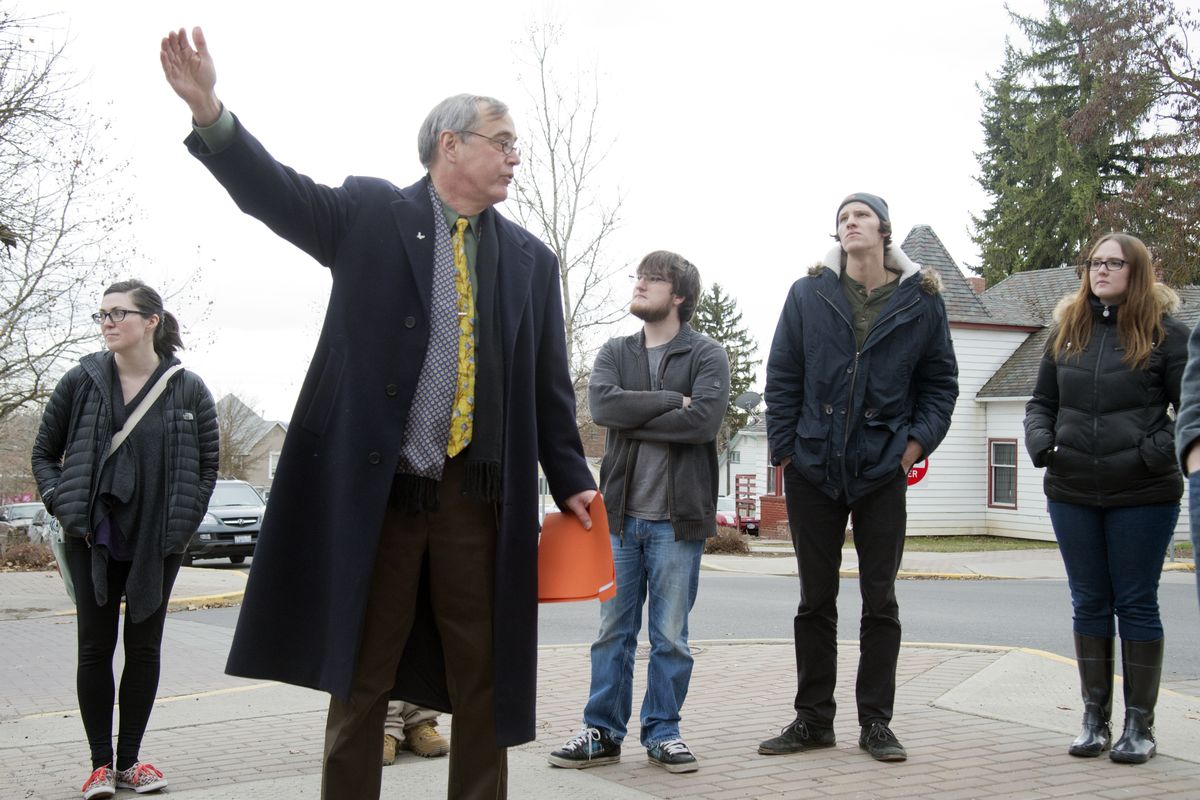EWU prof turns students into diehard local historians

On a cold gray Tuesday afternoon in Cheney, Larry Cebula tells his students to grab their jackets. The Eastern Washington University history professor pulls a long, wool overcoat over his suit, throws a scarf around his neck and looks out at his class: “Let’s take a walk.”
They walk across campus – in twos and threes, across lawns of crunching brown leaves – to see what has become of the place where, 130 years ago, a mob broke into the rickety wooden jail, looped a rope around the neck of an “unnamed Indian,” lobbed it over a sturdy branch and yanked it until the man was dead. These students have read yellowing articles about the incident, but history looks different when you’re standing there.
When they get there, they stand silently in a semicircle looking for evidence of that past. But this corner – at Fourth Street and College Avenue – is ordinary. There are no bloodstains, no scars from the frontier justice executed here so long ago. There’s a yellow fire hydrant. A parking lot. A light post. A red and white “No Parking Here to Corner” sign. A spindly, fatigued tree. Runners in neon speed by. A car passes, windows vibrating from a bassy stereo.
“What should we do here?” Cebula, 54, asks his students. “What should we do with this site?”
They’re quiet for a second. Then a student with an Amish-style beard says a monument would commemorate something no one would want to remember. “Although I would say I would rather have a monument than this nasty parking lot,” another student counters. They all laugh.
Well maybe a monument won’t happen, Cebula says, but what about something less permanent? Something less formal?
For the past two years, in fact, Cebula and his history students have bypassed bureaucracy and popular opinion, compiling digital markers for more than 400 historical points of interest in the Spokane area. They do it digitally, on the website SpokaneHistorical.org and its matching smartphone app.
It is arguably one of the largest, most readily accessible collections of local historical data. Users can pull up a self-guided walking tour of Browne’s Addition after taking in a pint at The Elk. Another walking tour tells the story of Spokane’s trademark ghost signs – the faded advertisements painted on the sides of downtown’s brick buildings.
Cebula’s site is the cornerstone of several of his history classes, like this one today – History 389: Public History. His students do the research, and they write stories about things they are interested in. When they’re done, the stories go online for anyone to enjoy.
For Cebula, who is also a digital archivist at the Washington State Archives, Spokane Historical came after he realized the work his students were investing in standard seven-page research papers was being wasted.
“The student researches something and writes it and gives the professor a paper. The professor makes a certain number of red marks on it, puts a grade on it and gives it back to the student,” he says. “And the student takes this paper – in which they invested 10, 30, 100 hours? – and throws it in the trash.
“We’re just burying all this research every year. We’re burying all this effort.”
But with Spokane Historical, Cebula turns the tables. His students are the historians: “They have to go to the primary sources,” he says. “I get them fired up and then send them into the documents. And then catch them when they fall.”
Spokane Historical paints a portrait of the Lilac City as a fantastical place rarely remembered – a metropolis with such a vibrant history no one would ever dare to call the city boring again. Students capture the excitement around Harry Houdini’s 1910 jump from the Washington Street Bridge. They tell tales of the seedy Trent Alley, where a 1912 newspaper writer said “all along the alley the rattle of ivory chips and dominoes could be heard … and the click of the cue ball was also in evidence.”
Cebula’s students bring safely archived information to the public’s fingertips with richly written true stories. There’s a profile of the short life of a downtown call girl named Irish Kate, who died in 1892. A digital marker placed at the site of the downtown statue of President Abraham Lincoln pulls up graying photographs of crowds filling the street, listening to soon-to-be President John F. Kennedy vying for their votes from the statue’s feet. There are even stories of why apples were served to President Taft in 1909 at the Davenport Hotel. And the site content stretches far beyond the city borders, into the Palouse, Central Washington and Eastern Montana.
This isn’t replacing the historical research that’s already been done, Cebula says. His students are simply providing new points of view, new ways of telling stories, or giving credence to tales – like this unnamed man who was hanged at Fourth and College – that historians might not be able to. This is an addendum to the history we already know. “Some of those brass signs around the Falls will be there in 300 years,” he says. “Will Spokane Historical? We’ll see.”
Back on the street corner, his students don’t seem to think a marker commemorating a lynching would be accepted by Cheney residents. “No one wants to put a marker here?” Cebula says. “You’re all very tame public historians! You’re gonna have successful, uncontroversial careers!”
But what about a mention online? The students nod.
“The great thing about doing public history with Spokane Historical,” he says to them, “is we can just do it.”